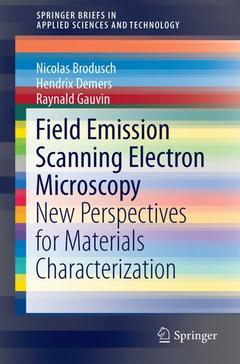Field Emission Scanning Electron Microscopy, 1st ed. 2018 New Perspectives for Materials Characterization SpringerBriefs in Applied Sciences and Technology Series
Auteurs : Brodusch Nicolas, Demers Hendrix, Gauvin Raynald

This book highlights what is now achievable in terms of materials characterization with the new generation of cold-field emission scanning electron microscopes applied to real materials at high spatial resolution. It discusses advanced scanning electron microscopes/scanning- transmission electron microscopes (SEM/STEM), simulation and post-processing techniques at high spatial resolution in the fields of nanomaterials, metallurgy, geology, and more. These microscopes now offer improved performance at very low landing voltage and high -beam probe current stability, combined with a routine transmission mode capability that can compete with the (scanning-) transmission electron microscopes (STEM/-TEM) historically run at higher beam accelerating voltage
2. Developments in field emission gun technologies and advanced detection systems
3. Advanced specimen preparation
a. Surface preparation
b. Surface cleaning
c. Charging compensation with ionic liquid treatment
4. Electron detection strategies for high resolution imaging: Deceleration and energy filtration
a. Principles
b. Application of dual in-lens electron detection
c. Energy filtration
5. Low voltage SEM
a. Strategy of characterization: deceleration and energy filtration
b. High resolution imaging
c. Low voltage, specimen charging and material contrast
d. Ultra-low voltage SEM: uses and limitations
6. Low voltage STEM in the SEM
7. X-ray imaging
a. X-ray imaging with a large solid angle annular silicon drift detector
b. Material science applications: Mapping at high resolution with high signal-to-noise ratio
c. The f-ratio method for quantitative x-ray analysis
8. Electron diffraction techniques in the SEM
c. Electron Backscatter Diffraction
d. Dark-Field Electron Backscatter Diffraction
e. Transmission Forward Electron Backscatter Diffraction
f. Dark-Field Imaging with a Forecaster Detector in Transmission Mode
9. Magnetic domain imaging
10. General conclusion and perspectives
Dr. Hendrix Demers is a Research Associate in material engineering department at McGill University, Montreal, Canada since 2012. He received his PhD in Mining and Materials Engineering at the McGill University, Montreal, Canada in 2008. He is involved in the field of microscopy and microanalysis by developing new methods for quantitative x-ray microanalysis, for materials characterization, and data and image analysis. He is also author and co-author of a world-renowned research softwares (Win X-Ray, MC X-ray, and CASINO) and aims at helping SEM users in their X-ray microanalyses, metrology applications and in more advanced applications such as electron beam lithography. He won the Castaing Award in 2008 for the best student paper and the Heinrich Award in 2010 for the Outstanding Young Scientist from the Microbeam Analysis Society of America. He is also an Academic Editor of the Scanning journal.
Prof. Raynald Gauvin is full Professor at McGill University, Montréal, Canada. His research interest are related in developing new methods to characterize the microstructure of materials using high resolution scanning electron microscopy with x-ray microanalysis and Monte Carlo simulations. He is the creator of the CASINO program that is used by mor
Date de parution : 10-2017
Ouvrage de 137 p.
15.5x23.5 cm
